Again in January, I wrote about Archer-Daniels Midland ($ADM) after the inventory dropped 25% – its largest ever one-day decline – on the heels of suspected company fraud.
I ended that put up with the next paragraph:
That is anecdotal and fewer scientific, however very hardly ever will shares “entice door” out of nowhere. Normally there are seismographic indicators which are usually detectable with development. Once more, very anecdotal in nature, however I can’t assist however recall Silicon Valley Financial institution ($SIVB) in March of final yr. In an in any other case flat/range-bound market, that inventory was down almost 50% within the 12 months main as much as its shock March 8 providing, which despatched the inventory down one other 25% after-hours enroute to a really swift conservatorship and chapter.
Let’s make this much less anecdotal, if not a bit extra scientific
On the very least, I needed to see if the “shares don’t entice door out of nowhere” instinct is directionally correct and never simply market lore, and if one thing like a inventory’s 200-day easy shifting common may work as a protection mechanism towards a lot of these value strikes. In different phrases: do most inventory dives come out of the blue, or are there potential warning indicators that we are able to systematically make use of prematurely?
As an ocular FYI, listed here are the charts of each $ADM and $SIVB main as much as their most up-to-date value plummets. They aren’t fairly. The blue line within the two charts under represents the straightforward 200-day shifting common, which is commonly considered an enormous/dumb proxy for a inventory’s longer-term value development. I say large/dumb as a result of it’s a well known indicator, and an indicator that doesn’t have an actual or apparent origin.
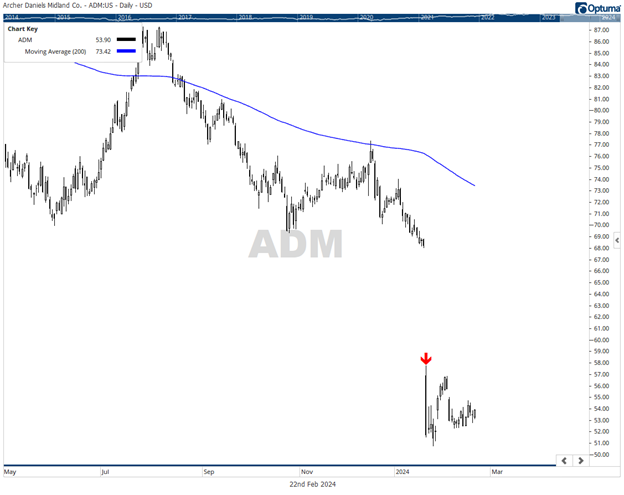
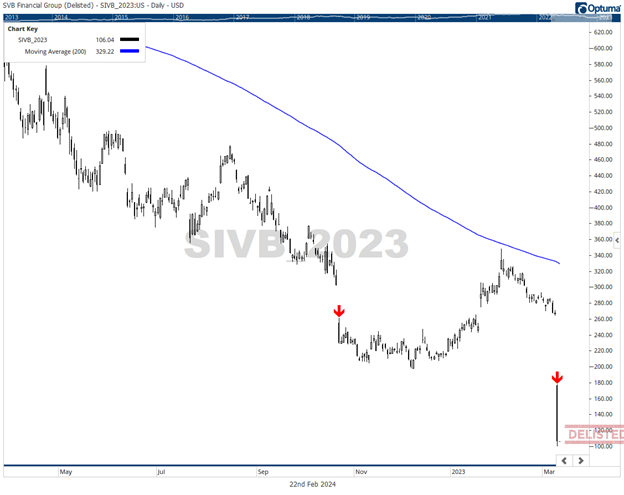
I’ll admit, this line of pondering isn’t essentially novel. Listed below are a few different notable researchers and buyers who really feel the identical manner (any emphasis is my very own), and if I’m being trustworthy, these quotes in all probability planted the seed for this instinct many moons in the past!
“Certainly one of my early mentors usually remarked, ‘Nothing good occurs under the 200-day.’ This was his manner of recognizing that, whereas shares can definitely pop larger from beaten-down ranges, you’re extra prone to expertise sustained advances as soon as the worth is above the 200-day shifting common. His remarks jogged my memory of profitable chartists like Tom Dorsey relating level and determine charts to soccer: ‘Are you able to rating a landing when the protection is on the sphere? Positive. Nevertheless it’s manner simpler to attain a landing when your offense has the ball!’” -David Keller, CMT
David Keller was clearly talking in regards to the reverse use case for the 200-day – i.e., being in shares above the 200D to extend the probability of features slightly than to lower the probability of losses – however the logic nonetheless applies. I additionally included his “Tom Dorsey / level and determine” reference as a result of, as long-time shoppers are probably conscious, we’re large proponents of the Dorsey Wright “PnF” methodology, and it closely informs our Monument Wealth Administration Dividend and Progress Fashions.
One other angle to David Keller’s ideas that I’ve seen over my years as an advisor: many individuals balk at proudly owning shares at or near their all-time highs, for concern of those steep falls or rug-pulls. The concern isn’t utterly unwarranted, as shares can and do turn out to be “overbought” of their journey to new highs, however that’s a part of the method of proudly owning good shares over the lengthy haul. This concern is maybe additionally a put up for an additional time (“good” overbought versus “dangerous” overbought).
Along with David Keller, let’s see what a hedge fund legend has to say:
“My metric for every thing I have a look at is the 200-day shifting common of closing costs. I’ve seen too many issues go to zero, shares and commodities. The entire trick in investing is: “How do I maintain from shedding every thing?” For those who use the 200-day shifting common rule, you then get out. You play protection, and also you get out.” -Paul Tudor Jones
With these two quotes as a backdrop, I made a decision to run a scan of steep one-day value drops in large-cap shares.
A (Easy) Historic Have a look at the 200-day Transferring Common
The next snip illustrates distinctive cases, over the past 20 years, of one-day value drops of S&P 500 constituents (accounting for survivorship bias) of greater than 20%. Based on my scan (my full scripting isn’t seen on the display screen), there have been 1,607 distinctive occasions throughout 448 completely different tickers (i.e., some shares had a number of cases). As you may guess, or are questioning, 350 (or over 20% of such cases) occurred throughout COVID in 2020. For those who’d like a full itemizing of those occasions, shoot me an e mail.
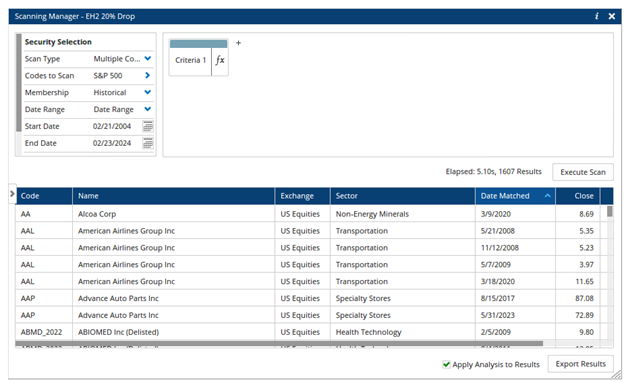
Subsequent, I needed to see what number of of these 1,607 one-day drops occurred whereas the inventory was above its 200-day easy shifting common (particularly, when the inventory’s prior shut was above its 200-day SMA).
Solely about 15% of our complete cases (or 244, unfold throughout 153 completely different tickers) occurred when the inventory had beforehand closed above its 200-day easy shifting common. So, giant value declines (as we’ve outlined them) above the 200D should not unprecedented, however historically-speaking, they’re not going. And going again to 2020, there have been 63 distinctive cases.
- 2020: 22
- 2021: 21
- 2022: 6
- 2023: 9
- YTD 2024: 4
- Your 2024 declines embrace Unisys Corp ($UIS, $340M market cap), Palo Alto Networks ($PANW, $88B market cap), Teradata Corp ($TDC, $3.7B market cap) and Adtalem World Training ($ATGE, $1.8B market cap).
- And for our shoppers who’re questioning: Tremendous Micro Laptop ($SMCI) just isn’t an SPX constituent and was down 19.99% on February sixteenth. (Extra on this subject throughout our month-to-month mannequin updates).
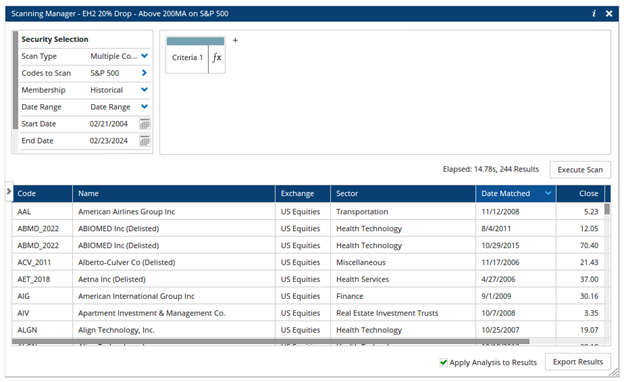
For completion’s sake, in working a scan for the other situation, I discovered 1,354 distinctive cases the place a inventory had beforehand closed under its 200-day easy shifting common and subsequently went down 20%+ within the following session. Mixed with the prior part, this appears to verify the suspicion that a lot of these one-day value shocks are probably detectable or maybe preventable via some form of development evaluation. Since 2020, there have been 434 such cases:
- 2020: 328
- 2021: 9
- 2022: 40
- 2023: 54
- YTD 2024: 3
Your 2024 declines embrace Archer-Daniels Midland ($ADM, $28B market cap), Massive Tons ($BIG, $117M market cap) and The E W Scripps Firm ($SSP, $451M market cap).
Programming be aware half 1: astute readers may be questioning how on earth firms like $BIG and $SSP may presumably be within the S&P 500 with sub-$1B market capitalization – the reply is that my scan included historic SPX constituents (survivorship bias!) over the previous 20 years. $BIG was faraway from the SPX in 2023, whereas $SSP was eliminated in 2008. So, this evaluation could possibly be additional refined with out together with this conservative course of.
Programming be aware half 2: I’m conscious that 1,354 and 244 don’t add as much as 1,607 – we’re 9 cases quick. I’m understanding this knowledge “kink,” however I believe that my scripting doesn’t account for shares than closed immediately on their 200-day – I’m engaged on resolving this.
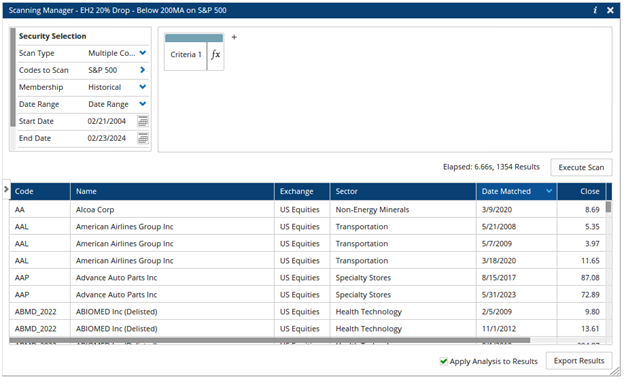
The Takeaway? Not Foolish. Not Seismic. However it’s a Good Beginning Level
To conclude, I really feel reasonably assured in confirming the instinct that the 200-day shifting common is an efficient start line for fascinated about a danger administration framework, at the very least on the subject of investing in particular person shares. Paul Tudor Jones wasn’t loopy in his evaluation {that a} good beginning place, for danger administration, is taking a look at a longer-term shifting common. The 200D isn’t a novel indicator with guarantees of a simple path to riches, however it does appear to be a reasonably good “blunt software” for doubtlessly avoiding catastrophe (i.e. 20%+ value declines) in particular person equities.
The flip facet of this: for any DIY investor, it can take dedication and ongoing monitoring of positions, and in an effort to maintain your self insulated from precipitous drops, you additionally probably take your self out of some fairly feisty “imply reversion” strikes or the beginning of recent long-term uptrends. You possibly can’t have your cake and eat it too, sadly.
For Monument Wealth Administration shoppers invested in our single inventory Dividend and Progress fashions, the 200-day SMA just isn’t an specific enter in our methodology, however as a byproduct of our level & determine charting knowledge, we most of the time discover ourselves in tickers above the shifting common.
Till subsequent time, have a fantastic weekend.
Erin

